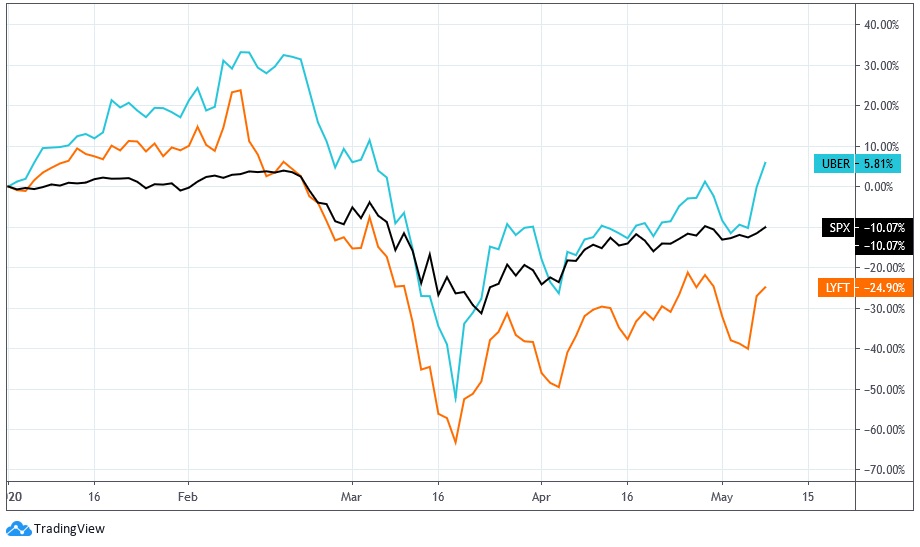eResearch | This week, Uber Technologies Inc. (NYSE: UBER) and Lyft Inc. (NASDAQ: LYFT) reported their Q1/2020 earnings, however, it was right after California’s attorney general sued them for violating the recently passed state law regarding the classification of gig economy workers.
In the recent quarter, Uber and Lyft continued to incur high net losses but both companies announced guidance for sustainable paths towards profitability with expectations to be EBITDA positive by the end of 2020.
Unfortunately, the two ride-sharing companies had a rough Q1/2020 as the COVID-19 pandemic significantly decreased demand for ride-sharing as consumers limit social interactions.
Uber is focusing on its Uber Eats food delivery arm as consumers stay isolated at home, while Lyft, who is only focused on ride-sharing, has taken drastic measures to significantly reduce operational expenses to be prudent during uncertain economic times.
A review of Uber and Lyft’s 2019 financials can be seen in an article posted on February 11, 2020 – “Uber and Lyft 2019 Performance and 2020 Guidance”
See below highlights on Uber and Lyft’s Q1/2020 financial reports, as well as further details on the effects of the lockdowns.
Uber
 In Q1/2020, Uber maintained positive revenue growth of 14% to US$3.5 billion due to its Uber Eats business experiencing a 57% increase in revenue while its main Uber Rides segment only increased by 2%. However, Uber continues to struggle in generating profits with a 190% increase of net losses to US$2.9 billion, mainly due to US$2.1 billion in investment write-downs.
In Q1/2020, Uber maintained positive revenue growth of 14% to US$3.5 billion due to its Uber Eats business experiencing a 57% increase in revenue while its main Uber Rides segment only increased by 2%. However, Uber continues to struggle in generating profits with a 190% increase of net losses to US$2.9 billion, mainly due to US$2.1 billion in investment write-downs.
As most communities shutter indoors due to the lockdowns, Uber Rides was significantly affected, which has led the ride-sharing company to focus on its Uber Eats food delivery arm, in addition to preserving strength to its balance sheet.
To reduce operational costs, Uber recently laid off 3,700 corporate employees, which makes up 14% of its workforce. Uber also recently exited eight unprofitable locations for Uber Eats to additionally improve its balance sheet and reduce liquidity risks.
In light of the COVID-19 pandemic, Uber has taken numerous steps to support the community, including 10 million free rides for essential works and people in need, and the waiving of fees for new Uber Eats partners.
Uber Q1/2020 Financial Highlights
- Revenue of US$3.5 billion, a 14% increase year-over-year, due to a 2% increase in Uber Rides to US$2.5 billion, a 53% increase in Uber Eats to US$819 million, a 57% increase in Freight to US$199 million, and a 66% increase in Other Bets to US$30 million.
- Operational Expenses of US$4.8 billion, a 16.3% increase year-over-year, mainly due to a 103% increase in SG&A costs to US$859 million, a 58% increase in R&D costs to US$645 million, and a 6% increase in Cost of Revenue to US$1.8 billion, offset by a 15% decrease in Marketing costs to US$885 million.
- Net loss of US$2.9 billion, a 190% increase year-over-year, attributed to US$2.1 billion in Pre-tax Impairment Write-downs and US$277 million in stock-based Compensation Expenses.
- Balance sheet includes Cash, Cash Equivalents and Short-term Investments of US$9 billion, Current Liabilities of US$6.6 billion, and Long-term Liabilities of US$11.1 billion.
Lyft
 In Q1/2020, Lyft also reported positive revenue growth of 23% to US$956 million, but unlike Uber, due to the COVID-19 pandemic, Lyft has taken drastic steps to cut costs down by US$529 million, decreasing operational expenses by 29% year-over-year
In Q1/2020, Lyft also reported positive revenue growth of 23% to US$956 million, but unlike Uber, due to the COVID-19 pandemic, Lyft has taken drastic steps to cut costs down by US$529 million, decreasing operational expenses by 29% year-over-year
To reduce operational costs, Lyft recently laid off 288 corporate employees, which makes up 17% of the workforce. Additional initiatives put in place to lower costs include a reduction in base salary for employees for 12 weeks, with up to a 30% cut to senior executive officers.
Lyft anticipates next quarter to be much harsher than Q1/2020, but it is confident that its US$2.7 billion in cash and short-term investments will be sufficient to provide flexibility in liquidity and comfort in capital needs.
As the crisis continues for the indefinite future, Lyft has implemented a new Health Safety Program with four initiatives, which include (1) the issuance of personal health certifications, (2) the requirement of face masks, (3) the education of health safety, and (4) the provisions of cleaning supplies and masks for drivers.
Lyft Q1/2020 Financial Highlights
- Revenue of US$956 million, a 23% increase year-over-year, mainly due to US$918 million generated from its ride-sharing business.
- Operational expenses of US$1.4 billion, a 29% decrease year-over-year, due to a 59% decrease in R&D costs to US$259 million, a 37% decrease in general and administrative costs to US$238 million, and a 29% decrease in marketing costs to US$196 million, offset by a 17% increase in cost of revenue to US$542 million.
- Net loss of US$398 million, a decrease of 65% year-over-year, mainly due to growth in ride-sharing revenue while operational expenses decreased by 29%.
- Balance sheet includes Cash, Cash Equivalents and Short-term Investments of US$2.7 billion, Current Liabilities of US$2.6 billion, and Long-term Liabilities of US$413 million.
California Sues Uber and Lyft
On May 5th, California’s attorney general sued Uber and Lyft for violating Assembly Bill 5, and both ride-sharing companies are expected to fight the claim.
Last year, California passed Assembly Bill 5, which went into effect on January 1, 2020, protecting gig economy workers who are misclassified as independent contractors and denied benefits such as minimum wage protections, sick leave, and unemployment insurance.
If Uber and Lyft lose the court case, it would set a precedent and could change the employment status of more than a million workers in California and, ironically, could lead to layoffs as they layoff contractors and hire fewer full-time employees or move the positions out of state.
//
Further details on California’s Assembly Bill 5 can be seen on an article posted on December 28, 2019 – “California’s New “Gig Economy” Labor Law Takes Effect on January 1 – Targets DoorDash, Lyft & Uber”
//
GRAPH 1: Year-to-Date Comparison Chart – UBER (+5.8%), S&P 500 (-10.1%), and LYFT (-24.9%)




